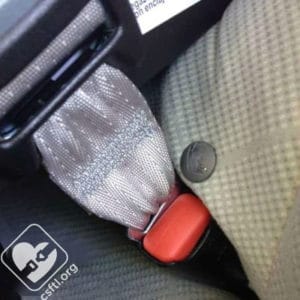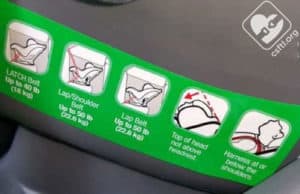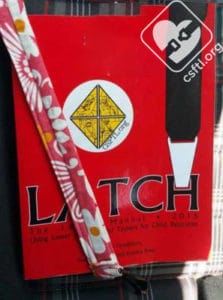LATCH (Lower Anchors and Tethers for CHildren) was phased in between 1999-2002 with the goal of giving parents a standard, foolproof method of installing their children’s seats. However, the advent of larger seats, and older children being restrained in those seats, has led to a concern that never occurred to the experts of 20 years ago; how much weight can those anchors actually bear in a crash?
LATCH includes lower anchors (the metal bar in the crevice, or bight, of the vehicle seat) and a tether (the hook above or behind the seating position to which the tether strap attaches). Passenger vehicles made after September 2002 are required to have two sets of LATCH and one additional tether.
What you might not know about LATCH is that it has a weight limit. A decade ago, most car seats had a 40 lb weight limit on the harness and the seat itself only weighed around 10 lbs. In contrast, today’s seats weigh 25 lbs or more and harness to 65 lbs or beyond. Child passenger safety technology is ever-evolving, and the Federal Motor Vehicle Safety Standards must evolve as well to make sure the installation methods can support heavier seats that are capable of harnessing larger children.
Here are the recent developments:
- NHTSA is using a 77 lb, 10-year-old dummy to crash test car seats with 65-80 lb weight limits and a 62 lb, 6-year-old dummy to crash test car seats with 50-65 lb weight limits.
- If the weight of the dummy plus the weight of the child restraint exceed 65 lbs, the car seat will not be tested using the lower anchors.
- All car seats manufactured after February 2014 will have a label that clearly defines the maximum weight limit for installing that car seat with lower anchors. That maximum weight limit will be 65 lbs when the car seat weight and the child’s weight are combined.
- Shortly before the February 2014 final rule went into effect, NHTSA added a few additional stipulations to the requirements for this labeling. Namely, allowing for the child restraint to round the maximum weight limit to the nearest number ending in 0 or 5. All car seats made after February 2015 are required to be in compliance with this final version of the labeling requirements.
What about the tether?
Using a tether has significant benefit for reducing a child’s head excursion and potential for injury in a crash. The specific labeling requirements set forth by NHTSA only extend to the lower anchors, not the tether. Many vehicles allow the tether to be used up to the weight limit specified by the car seat when the seat is installed with the seat belt, however, it’s important that you read both your car seat manual and your vehicle manual. Of course, we always recommend visiting a CPST to evaluate your individual situation.
What about booster seats?
Many belt positioning booster seats now come with lower anchor connectors, and several combination seats allow lower anchors, or the tether, or both, to be used when the seat is in booster mode. This is purely a convenience feature that keeps the booster from flying into other occupants if the vehicle is in a crash when the child is not in the seat. The seat belt does the heavy-duty work of restraining the child. Lower anchors only hold in the weight of the booster alone, so weight limits don’t apply.
What’s the bottom line? How do I find out the limit for my car and my car seats?
First, check your car seat manual and labeling. If your car seat was made around February 2014 or later, it will have a sticker that clearly defines which installation method you may use depending on the weight of your child. It’s also important to note that if your car seat was made around February 2015 or later, it may state a different limit than the same car seat made a year earlier.
If your car seat was made before February 2014, you may not have this label and things are a bit more complicated. Most vehicle manufacturers state a limit of 65 lbs when the car seat and the child’s weight are combined, some simply defer to the car seat manufacturer’s instructions, and some specify a 48 lb limit based solely on the child’s weight. CPSTs have a 200+ page manual detailing what each of the vehicle and car seat manufacturers say, and it’s not easy to consolidate that information into an easy answer. How can you find out? There are several options:
- Contact a CPST in your area. We recommend visiting a local CPST whenever you get a new car seat, a new car, or your child is moving up to the next stage. They’ll be able to help you determine the correct installation method for your children, vehicle, and car seats.
- You can always ask our team for help by visiting our Facebook Group, messaging our Facebook page, or sending us an email.
- Contact your car seat manufacturer via phone or email; they can always help with questions related to their specific seats.
- Still confused? Install your child’s seat using the seat belt. Check your vehicle manual and car seat manual for instructions on how to use the seat belt system.
Are you a CPST in need of the wonderful wealth of information contained in the LATCH Manual? It’s compiled by the amazing team at Safe Ride News, and you can order this fabulous resource online. We recommend every child passenger safety advocate have at least one…. each for your car, your living room, your bedroom, your office, and an extra just in case your toddler decides to color all the pages in a nice shade of blue.




